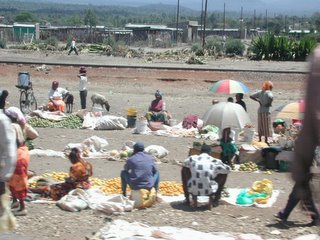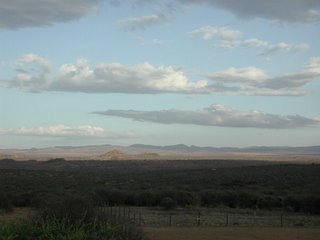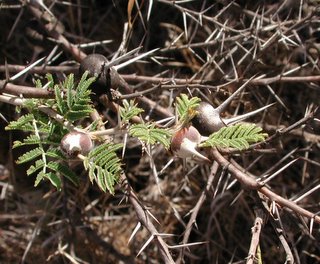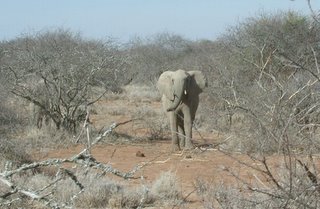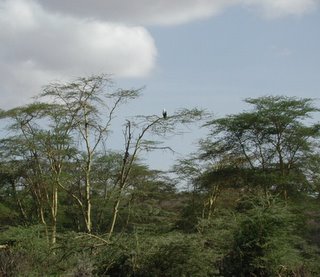Photos

Baboon cliffs, on Mpala land. We saw many, many baboons - they are startlingly human, both in their movements, social behaviour, and voices. When they bicker in the trees across the river at the campsite, they sound disturbingly like people in distress. We saw some babies, with thin, short black hair and pink faces, much cuter than the ruffed, fierce-looking baboon adults.

Sunset at the baboon cliffs, with a fever tree that had a bunch of weaverbird nests hanging in it - don't know if you can see them in this small picture, but they're those small black blobs hanging from the lower branches. All of the sunsets here have been amazing.

Acacia mellifora, in bloom. All of the acacia melliforas have been blooming, but none of the others. Not quite sure why that is. I'm getting better at identifying the different acacias. I can tell apart acacia mellifora, acacia drepanelobium, and acacia etbaica. (Too bad there are about 50 more varieites...)

Greg emerging from a Masai house.
The women build them. The roofs are made of a mixture of cow dung, soil, and water mixed together. Sometimes cow urine is used - not because it is a better liquid to hold it together, but because there's something significant about using the cow products to make the house. Inside, the houses are low and very dark; there is a fire-pit but no chimney, so all of the heat and smoke stays inside to keep the house warm at night, when the temperatures drop. The heat from the fire also helps bake on the roof mud. There are separate "bedrooms" for the husband and wife, and the children just catch as catch can.

Elephant spotted from the landrover - part of a fairly large herd with several babies. We were concerned for a bit that they might charge us - one of the young males mock-charged, but backed off. Landrovers have certainly been flipped by elephants before, and a British soldier was charged by one and taken to a hospital in Nairobi a couple of days ago. (The British army has training grounds nearby, and managed to piss off some elephants; it's never happened before, and the people at the Center were in fact more surprised that it hadn't happened already.)

A rhino! This female is 40 years old, one of the first ones at the Ol Jogi sanctuary. Absolutely amazing animal. Looks so prehistoric! Funny round ears. Dark, blurred, wise eyes with uneven lashes, staring out of mudcaked lids, regarding us. And astonishingly rare. There are about 600 Eastern Black Rhinos left in the world, most of them in Kenya. (It's a subspecies of the Black Rhino.)

Masai. Difficult to say what the experience of this village was, exactly... I couldn't tell if they were genuinely happy to see us; laughing at us; happy to profit from us; or irritated that they had to put up with our imposition on their culture in order that they could make some money. We danced with them, though, and it was wonderful.

Trained elephant at the Ol Jogi. Dude has his own circus, yo! This elephant could do tricks from grabbing one foot with his trunk and limping, to playing the harmonica. It was astonishing. We got to feed them, and the sensitive grasp of that moist, snuffling fifth limb was one of the most interesting things I've ever experienced... Got elephant goo all over my hand, which was fun. I also felt the rest of the trunk, which was much harder and bristlier than I had expected; I'd thought it would be much squishier. Beautiful, intelligent animal - the trainer would tell him what to do, and with an air of complete boredom, he would do it, while reaching up insistently to be rewarded with a carrot. "Why even ask me?" He seemed to be asking. "This is so far below my abilities, it's insulting. You know I can do the party trick. Just give me my snack."
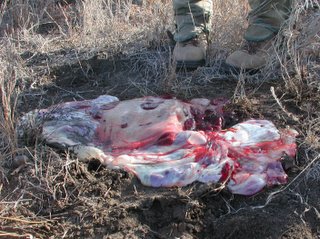
Giraffe afterbirth, found while doing fieldwork with Nathan in the early morning. Looked, as you can see, like you'd taken someone, turned them inside out, removed all the bones, and slapped them down on the ground in a blob. It was beautiful and strange, and very fresh - probably hyenas have found it and eaten it by now. Imagine being out on an early-morning bird walk, and suddenly, with no warning at all, THIS appears in your path. Truly bizarre.

The group! Taken awhile ago, on top of Mt. Kenya. Top row: Greg Schundler, Nick Lilly, Laurie Elachi, Mark Dalgarno. Second row: Melissa Ivins, Kirsten Ruch. Third row: Nathan Gregory, Me, Paul Pawlowski. Nathan, in case I haven't already mentioned it, is our TA. He's an awesome grad student, and we're all going to cry when he leaves in 2 weeks. What will we do without him?
Is there any interest in seeing photos of my paintings at all? They're basically just sketches, but I'm rather fond of them. On the other hand, I don't have any reason to photograph them unless you want to see them NOW instead of waiting till I get back.
Tore my pants climbing trees at the campsite. Those pants are henceforth exclusively tree-climbing pants. Oddly, shirt not torn.
Still working on my brevity, I promise. As well as cutting down on the superlatives.
Jenn

